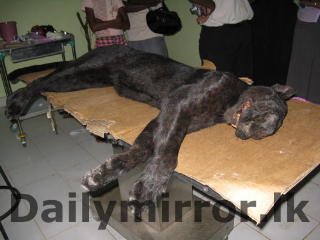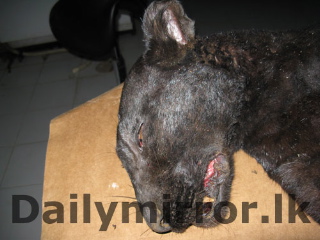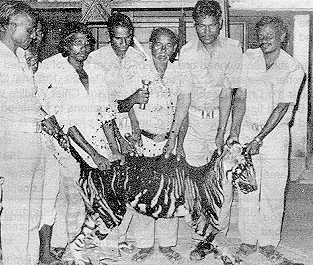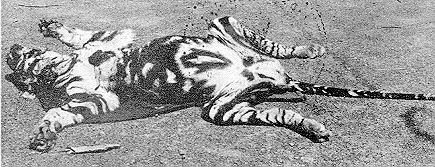Update: “Black Tiger” Found In Sri Lanka
Posted by: Loren Coleman on August 6th, 2010
Cryptomundo Correspondent Pradeep writes (August 6, 2010), confirming earlier thoughts:
“The confusion arises due to the Sinhala terms for the leopard and tiger.
“Leopard is diviya in Sinhala but is also called kotiya by the villagers. In fact the name of the subspecies is Panthera pardus kotiya.
“Tiger is viagra in Sinhala. However the tiger is also referred to as kotiya by some.
“Hence the confusion when translating kotiya into English.
“There are no indigenous tigers (4-legged) in SrI Lanka. The animal in question is a black leopard – a very rare melanistic version of the same old Panthera pardus kotiya!”
++++Previously noted in 2009:
It was reported by local media on March 7, 2009, that the carcass of a female “black tiger” was found in southern Sri Lanka on Friday, March 6, 2009.


The Daily Mirror (source of the photos) said the carcass of a “black tigress” was found after it got caught in a poacher’s snare in Deniyaya, around 125 miles (about 201 km) southeastern of the capital Colombo.
The newspaper quoted the Wild Life Department as saying that the black tiger’s length from head to tail is 3 ft 7.5 inches (1.1 meters), the height is 2 feet (0.61 meter) and the tail alone had measured up to 2 feet 4 inches (over 0.71 meter).
From a distance, its color is jet black and when inspected from a closer distance, spots are vaguely visible, the newspaper said.
“From a distance, its colour is jet black and when inspected from a closer distance, spots are vaguely visible,” Wadawalawa “Athathun Sevana” Vet Dr. Kumudini said. According to her, the “tigress” had not fully grown yet however because of the rarity of the species the exact age cannot be determined. (If “spots” are being seen, then why isn’t this a melanistic leopard? Is there some mistranslation here? The photographs have embedded labels of “Black panther.”- Loren.)
Dr. Kumudini also said that the “black tigress” showed signs that are common to the “Panthara Pardus Kotiya” (i.e. Panthera pardus kotiya, the Sri Lankan leopard) species. According to Dr. Kumudini there had been a similar discovery of a “black tiger” from the Kalavana area some years ago, yet the carcass had been too decomposed to gain proper identification.
She claimed that further investigations are necessary to determine whether the creature is a subspecies or a non-agouti mutation of the “Panthara Pardus Kotiya species” [sic].
The newspaper quoted an expert as saying that the “tiger” had not fully grown yet however “because of the rarity of the species the exact age cannot be determined.”
The “black tigers” are “very rarely species [sic] in Sri Lanka,” according to the Xinhua News Services. Experts said there had been a few sightings of “black tigers” from the Kalavana, Horton Plains and Sripada areas.
This seems clearly to be a black Sri Lankan leopard.
+ + +
Cryptozoologically, melanistic felids and black tigers are of interest. In 2007, camera trap photos were taken of an alleged black mother tiger and her two offspring in India. (See more, here.)
I wrote articles on melanistic felids, including black tigers which were published, some in the zoo literature, in the 1970s, and Karl Shuker nicely summarized old reports of black tigers and other black cats in his 1989 book, Mystery Cats of the World. Wikipedia has an easily accessible article detailing the long history of melanistic and black tiger reports and evidence, here.
While reports of such tigers in India and South Asia are often referred to as “black tigers,” reports of similarly-colored tigers in China frequently are termed “blue tigers,” or more rarely, “Maltese tigers.”
Needless to say, “black tigers” are not separate species or subspecies that have a different maturity rate of development than normal color phase tigers, despite what is being noted by the Asian media on the Sri Lankan report (which seems to be a black panther, a black leopard, not a tiger).
Photos of alleged black tigers are known, from the recent past.


On 21 July 1993, around 10 a.m., a boy, in self-defense, killed a young melanistic tigress with a bow and arrows. The incident occurred in the village of Podagad in the Bhandan river valley west of Similipal Tiger Reserve, India. The main peculiarity in body coloration was that the dorsal stripes were tawny and the ventral stripes white on a black background [or the black stripes were wider than the orange dorsal and white ventral backgrounds]. The animal was photographed (see photos) and videotaped.
+++
Sri Lanka photo assistance, thanks to theprof.
About Loren Coleman
Loren Coleman is one of the world’s leading cryptozoologists, some say “the” leading living cryptozoologist. Certainly, he is acknowledged as the current living American researcher and writer who has most popularized cryptozoology in the late 20th and early 21st centuries.
Starting his fieldwork and investigations in 1960, after traveling and trekking extensively in pursuit of cryptozoological mysteries, Coleman began writing to share his experiences in 1969. An honorary member of Ivan T. Sanderson’s Society for the Investigation of the Unexplained in the 1970s, Coleman has been bestowed with similar honorary memberships of the North Idaho College Cryptozoology Club in 1983, and in subsequent years, that of the British Columbia Scientific Cryptozoology Club, CryptoSafari International, and other international organizations. He was also a Life Member and Benefactor of the International Society of Cryptozoology (now-defunct).
Loren Coleman’s daily blog, as a member of the Cryptomundo Team, served as an ongoing avenue of communication for the ever-growing body of cryptozoo news from 2005 through 2013. He returned as an infrequent contributor beginning Halloween week of 2015.
Coleman is the founder in 2003, and current director of the International Cryptozoology Museum in Portland, Maine.










Viagra means tiger?
This explains a great deal of recent golfing news as well as a somewhat weird drug name!!!
I don’t care if it’s a tiger or a leopard or a housecat. I’m sick and tired of f’n poachers killing everything in sight.